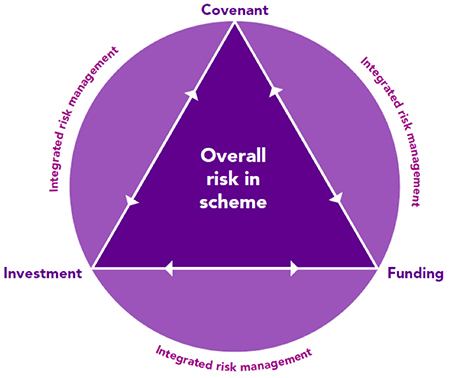From the blog: What if I told you that a diagram from the Pensions Regulator is an example of the artistic technique of stippling – where individual dots of paint are used to build up a picture?
The approach illustrated is essentially a framework on which to hang actuarial funding risk, investment risk and those risks relating to the strength of the sponsor’s business: their own investments, the market in which they operate and their continuing ability to support the pension scheme.
If trustees use the right framework, information from each adviser – actuarial, investment and covenant – can be pulled together to build up a clear picture of the risks the scheme is exposed to.
Artwork composed of many dots, famed by the likes of Seurat and Lichtenstein, the canvas simply looks like a collection of paint marks when you get up close.
Yes, you can see the colours and the shape of the individual dots, but you don’t really get a sense of how they relate to each other or what happens when you put it all together.
The figure below is taken from the Pensions Regulator’s guidance on integrated risk management, issued at the end of last year.

Risk framework
The approach illustrated here is essentially a framework on which to hang actuarial funding risk, investment risk, and those risks relating to the strength of the sponsor’s business: their own investments, the market in which they operate and their continuing ability to support the pension scheme.
If trustees use the right framework, information from each adviser – actuarial, investment and covenant – can be pulled together to build up a clear picture of the risks the scheme is exposed to
Working through this integrated model for risk management does not need to overcomplicate advice. If trustees use the right framework, information from each adviser – actuarial, investment and covenant – can be pulled together to build up a clear picture of the risks the scheme is exposed to.
The way these risks interact will also be visible, as will a view of how they might change over time and which are the most important to monitor.
The individual numbers taken at a single point in time neither matter nor really help trustees to take the right decisions.
A 'funding level on a technical provisions basis of 75 per cent at the valuation date', or a 'one-year value at risk of £50m with a 95 per cent confidence interval' don’t, on their own, give enough clear information for trustees to use to steer their schemes.
The clearer dashboard of integrated risk management shows how things might change over time, the range of what might happen, how much of that the employer will be able to withstand, and what will be done if things go wrong.
This gives trustees the big picture they need, rather than being left grappling with a collection of individual dots.
Marian Elliott is a director at consultancy Deloitte














